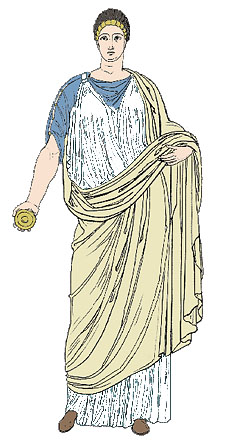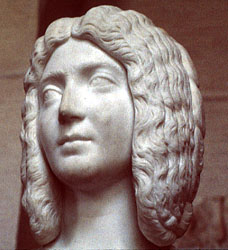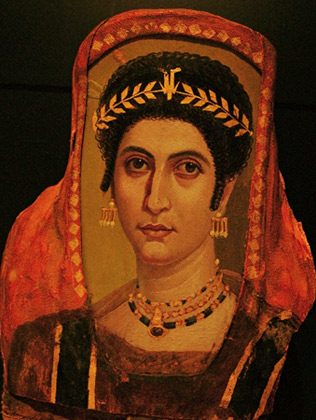| THE PEPLOS | |
 |
 |
ROMAN CLOTHING: WOMEN
Women cannot partake of magistracies, priesthoods, triumphs, badges of office, gifts, or spoils of war; elegance, finery, and beautiful clothes are women's badges, in these they find joy and take pride, this our forebears called the women's world. (Livy, History of Rome 34.5)
In the above passage, Livy quotes a Roman tribune's argument for the repeal of the Oppian Law, a wartime measure which curtailed the finery that upper-class Roman women could display and which provoked the first recorded protest demonstration by women, as aristocratic Roman matrons took to the streets in 195 BCE to urge repeal of the law (click here for the context of this passage). As the tribune pointed out, high-class Roman women did not have the same distinctions of clothing that immediately marked out the status of their male counterparts; in fact the only certain distinction of dress allowed to women was the stola, which indicated a woman's marital status, not her social class or wealth. In addition, except for minor variations of color or fabric, women's clothing styles were relatively simple and unchanging, so they had to emphasize elaborate hairstyles and jewelry in order to stand out from other women.
Similar to Roman men, the basic item of clothing was the tunic (tunica), though women's tunics were fuller and longer, usually extending to the feet. There were two basic styles of tunic, both similar to tunics worn by Greek women.
| THE PEPLOS | |
 |
 |
The peplos was made from two rectangular pieces of cloth partially sewn together on both sides; the open sections at the top were then folded down in the front and back. The woman pulled this garment over her head and fastened it at her shoulders with two large pins, forming a sleeveless dress; she then tied a belt over or under the folds. This statue shows a Roman woman wearing a peplos and holding a glass vial for perfume.
| THE CHITON | |
 |
 |
The more common sleeved tunic worn by women was similar to the Greek chiton. Two wide pieces of cloth were sewn together almost to the top, leaving just enough room for armholes. The woman pulled this garment over her head and used several pins or buttons to fasten it at intervals over her shoulders and arms, forming a dress with sleeves which could be belted under the breasts, at the waist, or at the hips. The length of the sleeves was determined by the width of the cloth. Statues clearly show the manner of fastening the sleeves as well as various modes of draping and belting the tunic. Tunics could be brightly colored or made of lightweight fabrics such as linen or silk, as in this wall painting of a fashionable young woman pouring perfume into a tiny container.
| THE STOLA |
 |
At the time of her
marriage, the Roman woman
donned the stola, a long, sleeveless tunic, frequently if not always
suspended at the shoulders from short straps, which was worn on top of another
tunic. It is probable that the stola was typically made of undyed wool. The
stola was a symbol of marriage, and by the late Republic all women married
according to Roman law were entitled to wear it. Not all did, of course, since
it was not a particularly fashionable or flattering garment, but wearing the
stola was a way for a woman to publicly proclaim her respectability and
adherence to tradition. Statues of the
first empress Livia, for
example, prominently display her stola, even
this one whose head has been
lost (a
close-up clearly shows the
strap of her stola).
As the drawing at left shows, respectable women also wore a long cloak, called a palla, over their tunic and stola when they went outside. This was rectangular in shape and was typically draped over the left shoulder, under the right arm and back across the body, carried by the left arm or thrown back again over the left shoulder. The palla could also be pulled up to cover the head, as shown in the above statue of Livia or in this depiction of a matron whose elegantly draped palla has a fringe.
HAIRSTYLES:
Women relied mostly on elaborate hairstyles and jewelry rather than clothing to vary their appearance (see hairstyle 1, hairstyle 2, hairstyle 3, and hairstyle 4). In fact, an elaborate hairstyle is the only thing worn by this woman, who had herself sculpted as the goddess Venus (I like to imagine that this sculptor had an ironic sense of humor, since the contrast between her realistic portrait head and the prefab Venus-like body is so striking). Some of these styles were influenced by coiffures adopted by empresses, as for example the unusual hairstyle worn by Julia Domna during the latter half of the second century CE:, shown in this coin and in the two views of her sculpted head below. In fact, some lucky Roman girl of that period had a beautiful jointed ivory doll wearing a gold necklace, bracelets, and anklets, with a hairdo imitating that of the empress. This doll also proves that Barbie was not the first anatomically correct “fashion doll”! No doubt this doll's owner dressed her in elegant clothes mimicing those worn by aristocratic women.
 |
 |
One of the most famous styles was worn by women during the period of the Flavian emperors (Vespasian to Hadrian, 69-138 CE); this is the style that Juvenal mocks when he describes the woman who appears tall from the front but quite the opposite from the back (on this sarcophagus a woman with a Flavian hairstyle proudly displays the bust of an important male in her family; note her stola as well). Numerous slaves skilled in the arts of hairdressing and cosmetics were needed for these elaborate hairdos, as were hairpins (shown here with a beautifully carved ivory box in which to store them), wigs, and hair swatches. This hairpin made of bone is topped by the carved head of a woman with an elaborate hairstyle, while this one bears an inscription and originally showed the heads of a couple (the woman's head has broken off). Women also wore hairnets made of finely woven gold wires; this gold hairnet from Rome mirrors the hairnet shown on this Pompeian fresco portrait of a girl (often mistakenly labelled “Sappho”). Women also had many creams, cosmetics, and perfumes; this cosmetic box belonging to a woman in Pompeii was made of bronze and beautifully carved bone (wood portions have been restored). Cosmetics and hairstyling required mirrors, which were made of highly polished bronze or silver in rectangular or round shapes. The most elaborate had handles and relief carvings on the back, like this silver mirror depicting the myth of Phrixus riding the ram with the golden fleece.
JEWELRY:
 |
Fashionable upper-class women wore considerable amounts of jewelry. One design that persisted from a very early period to late antiquity was the fibula, a pin whose basic design resembled our safety pin. It was a useful clothing fastener and was often beautifully decorated, as is the case with this Etruscan gold fibula depicting a cat stalking two unsuspecting birds. Since Roman clothing was frequently pinned rather than sewn, many fasteners were beautifully decorated; this gold pin has an amethyst cameo with a female bust, and the large garnet in this pin has an winged Victory intaglio carving. A representative collection of jewelry from the first to the third centuries CE includes earrings, necklaces, pendants, bracelets and rings of gold, gems (garnets were especially popular), and cameos (here is another collection of Roman jewelry). Gold bracelets were often fashioned in the form of snakes (see another snake bracelet with carved scales), and rings often had relief carvings, like this gold betrothal ring with a couple clasping right hands, or intaglios, like this camel. A popular style of jewelry apparently invented by the Romans was made of hollow, polished gold hemispheres fashioned into necklaces, bracelets, and earrings. Pearls were particularly prized and costly; this impressive gold necklace, found in Pompeii, is set with emeralds and large pearls. Silver was used less frequently, as in this medallion with chain, this bracelet with a portrait of a child, or this ring showing two snakes holding in their mouths a patera (a dish used in religious ceremonies). This silver ring has an inscription (with letters in reverse for stamping) that reads LIBERA VIVAS, “may you live free.” Cameo portraits were also worn, as in this pendant depicting a married couple or in this striking gold pendant with glass beads and plasma cameos of the faces of children. Gold coins (aurei) were often made into jewelry: a gold ring with a coin of the emperor Marcus Aurelius, a pendant with garnets and a coin of the emperor Caracalla, an armband with coins of Caracalla and his wife Plautilla, and a belt made with coins of fourth-century CE emperors Constans to Theodosius. The portrait of the woman at left is one of many so-called “mummy portraits” dating from Egypt after it became a Roman province; these portraits, usually depicting only the face and shoulders, present us with strikingly individualized faces of varying ethnicities, Greco-Roman clothing, adornment, and hairstyles, combined with the quintessentially Egyptian custom of mummification. We know that this woman was named Isidora, since her name is painted in Greek on the wooden sarcophagus, and her hairstyle dates to the period of the emperor Trajan, the beginning of the second century CE.
Barbara F. McManus, The
College of New Rochelle
bmcmanus@cnr.edu
revised August,
2003